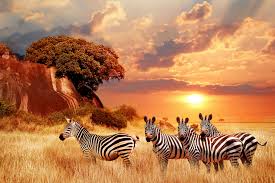Maasai Mara, Kenya
🐘 Maasai Mara, Kenya: Africa’s Wild Symphony of Nature and Culture
Tucked into the remote southwestern corner of Kenya, the Maasai Mara National Reserve is more than just a safari destination—it's a living theatre of nature, culture, and raw African beauty. From the roars of lions echoing across golden grasslands to the rich colors of Maasai beadwork, the Mara is where the wild and the wondrous coexist in harmony.
🗺️ Where the Wild Roams Free
Stretching over 1,510 square kilometers, the Maasai Mara is a continuation of the Serengeti ecosystem, connected to Tanzania’s Serengeti National Park by an unfenced border that allows free animal migration. The Mara is especially famous for hosting one of the greatest natural spectacles on earth—the Great Migration—but it’s a gem to explore year-round.
Imagine acacia-dotted savannahs shimmering under an amber sun, herds of elephants gracefully crossing riverbanks, and cheetahs perched atop termite mounds scanning for prey. The Mara is not a zoo—it’s an unscripted, live-action documentary.
🦓 The Great Migration: A Moving Miracle
Between July and October, more than 1.5 million wildebeest, zebras, and Thomson’s gazelles thunder through the Mara plains, crossing from the Serengeti in search of greener pastures. This phenomenon, known as The Great Migration, is a test of survival: animals must dodge crocodiles in the Mara River, big cats on the plains, and harsh natural elements.
Watching a river crossing is the safari equivalent of witnessing a solar eclipse—it’s rare, dramatic, and unforgettable. You’ll hold your breath as herds hesitate at the water’s edge, then erupt into a flurry of hooves, splashes, and life-or-death choices.
🦁 Big Five, Big Moments
While the migration steals headlines, Maasai Mara’s year-round residents are no less impressive. The park is one of the best places in the world to see the Big Five:
-
Lion – Including the famed Marsh Pride, stars of BBC’s Big Cat Diary.
-
Elephant – Often seen in majestic matriarchal herds.
-
Leopard – Elusive but often spotted along the Talek River.
-
Buffalo – Gruff, powerful, and ever-present.
-
Rhinoceros – Both black and white rhinos can be found, though sightings are rare.
Add cheetahs, hyenas, hippos, giraffes, and over 470 bird species, and the Mara becomes a true ark of biodiversity.
🎈 Balloon Safaris: The Sky’s the Limit
One of the most magical ways to witness the Mara is from above. Imagine drifting silently in a hot air balloon at sunrise, watching as giraffes meander below and the savannah slowly awakens in gold and crimson hues. After landing, you’re treated to a champagne breakfast right in the bush—an experience both romantic and exhilarating.
🛖 Meet the Maasai: Guardians of the Land
No visit is complete without connecting with the Maasai people, the semi-nomadic tribe after which the reserve is named. Clad in bright red shúkàs (cloth wraps) and adorned with intricate beadwork, the Maasai are cultural icons of East Africa.
You can visit a Manyatta (village) to learn about their customs, traditional dances, and even how to start a fire using sticks and cow dung. The Maasai have lived alongside wildlife for centuries, maintaining a delicate balance between conservation and pastoral life.
🏨 Safari in Style: Where to Stay
Whether you’re a budget backpacker or a luxury traveler, the Mara offers a range of accommodations:
-
Luxury Lodges: Stay at the JW Marriott Masai Mara Lodge, where five-star comfort meets raw nature. Think infinity pools overlooking watering holes.
-
ented Camps: Opt for an eco-luxury tented stay at Mara Explorer Camp, blending rustic charm with modern comfort.
-
Budget Options: Places like Enchoro Wildlife Camp offer clean, simple lodgings with a real bush feel.
Pro tip: Choose a camp inside or near the reserve for early access to game drives and less time on bumpy roads.
📸 Photographer’s Paradise
Golden hour in the Maasai Mara is a visual feast. Soft light bathes the plains, animals are most active, and every click of the shutter captures pure magic. Whether you’re an amateur or a NatGeo hopeful, the Mara rewards you with frame-worthy shots—a lion mid-roar, a cheetah sprinting through dust, or a Maasai child smiling shyly behind beaded jewelry.
📝 Important Travel Tips
-
Best Time to Visit: July–October for the migration; January–March for baby animals and fewer crowds.
-
Malaria Precaution: Pack insect repellent and consult your doctor about anti-malarials.
-
Visa: Most nationalities can apply online for a Kenyan eVisa.
-
Connectivity: Mobile service is good in lodges, but expect limited internet in remote areas—disconnect and immerse.
✨ Final Word
Maasai Mara isn’t just a destination—it’s a spiritual journey. It reawakens your sense of awe, your respect for nature, and your connection to ancient ways of life. Whether you come for the thunder of hooves, the echo of lion calls, or the warm embrace of Maasai hospitality, you’ll leave with a heart fuller than you imagined.


